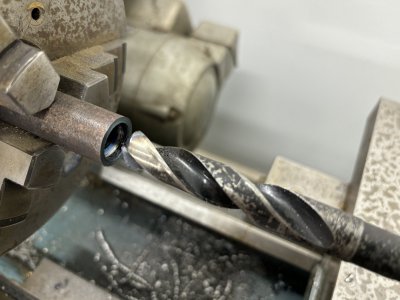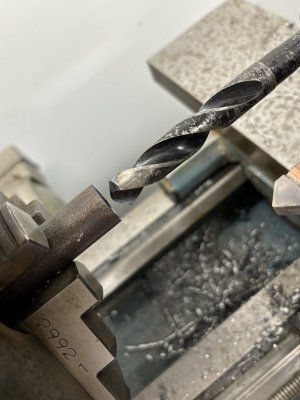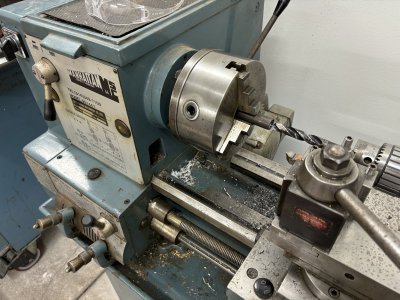I seem to have an issue with burning up my drill bits. Today was particularly frustrating and I could use some advise.
On the lathe, I was using a 9/16” drill bit to bore a hole in mild steel (.75” diameter). I had previously used a 3/8” bit as a pilot hole. The 3/8” hole was 2.25” deep and though I also had problems with that one, I am focusing on the 9/16” problem. I used the formula (100 x 3.82 / .5625) which gave me an RPM of 679. I chose the 560 RPM on my lathe. Initially it appeared as though all was well. I had nice curly chips about an inch long rolling out of both sides of the flutes. I had medium pressure and it was a steady chip load coming out. When I got about .75” into it, the chips rapidly became dust and everything overheated leaving me with no chips coming out, a scorched blue part, and yet another trashed drill bit. I might add all my drill bits are used but it appeared to be cutting very well at first and sharp. I’d like to fix my drilling problem before investing in nice new bits so I don’t destroy them.
This is almost the same problem I had with the 3/8” bits except they both lasted 1” each. I tried using cutting fluid on the second one but that made no difference.
I appreciate any help.
On the lathe, I was using a 9/16” drill bit to bore a hole in mild steel (.75” diameter). I had previously used a 3/8” bit as a pilot hole. The 3/8” hole was 2.25” deep and though I also had problems with that one, I am focusing on the 9/16” problem. I used the formula (100 x 3.82 / .5625) which gave me an RPM of 679. I chose the 560 RPM on my lathe. Initially it appeared as though all was well. I had nice curly chips about an inch long rolling out of both sides of the flutes. I had medium pressure and it was a steady chip load coming out. When I got about .75” into it, the chips rapidly became dust and everything overheated leaving me with no chips coming out, a scorched blue part, and yet another trashed drill bit. I might add all my drill bits are used but it appeared to be cutting very well at first and sharp. I’d like to fix my drilling problem before investing in nice new bits so I don’t destroy them.
This is almost the same problem I had with the 3/8” bits except they both lasted 1” each. I tried using cutting fluid on the second one but that made no difference.
I appreciate any help.



